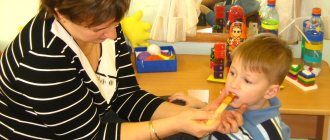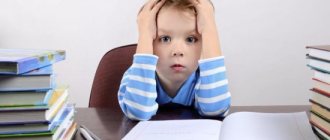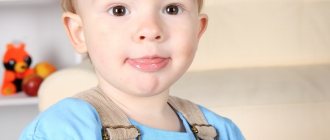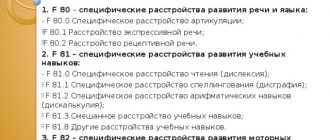Dysphasia is a persistent underdevelopment or complete absence of speech caused by organic lesions of the cortical areas of the brain responsible for speech development. Unlike aphasia, in which there is a loss of already formed speech (due to injury, vascular diseases of the brain, tumors, brain surgery, etc.), dysphasia begins to develop in the prenatal period or at the early pre-speech stage of the child’s development. The severity of the disease depends on the time at which the brain damage occurred; the most dangerous period is 3-4 months of pregnancy. In the Russian classification of diseases, this disease is called alalia (not to be confused with dyslalia - a distortion of speech, sound pronunciation, which is not considered a gross violation of speech development up to 5 years), and in various sources you can find the names: “developmental dysphasia” or “early childhood aphasia.”
What is developmental dysphasia?
Dysphasia is understood as persistent underdevelopment or complete absence of speech in a child. This pathology is associated with certain organic lesions in the cerebral cortex, which is responsible for the development of speech skills. Dysphasia is often confused with aphasia, in which the child stops speaking due to loss of speech skills. This happens as a result of severe injuries resulting in concussion, vascular diseases or surgery on the cerebral cortex, as well as its tumors.
Dysphasia always begins to manifest itself in the perinatal or early period of development of the infant's speech skills. The severity of the disease when visiting a doctor is determined based on the time of damage to the brain systems. The most dangerous periods are considered to be 3–4 months of pregnancy. A child with this disease not only cannot speak, but also often poorly understands the speech of the people around him.
REFERENCE! Dysphasia in the Russian classification of diseases is called alalia. This term should not be confused with the common disease dyslalia, in which the child has speech, but is severely distorted. Various sources also give the same type of name for dysphasia - this is “early childhood dysphasia” or “developmental dysphasia”.
Speech development disorders in children and their correction
Speech formation is one of the main characteristics of a child’s overall development. Normally developing children have good abilities to master their native language. Speech becomes an important means of communication between the child and the world around him, the most perfect form of communication inherent only to humans. But since speech is a special higher mental function provided by the brain, any deviations in its development should be noticed in time. For normal speech formation, it is necessary that the cerebral cortex reaches a certain maturity, the articulatory apparatus is formed, and hearing is preserved. Another indispensable condition is a complete speech environment from the first days of a child’s life. The main indicators of speech development from 1 year to 6 years are given in Table 1.
Speech is one of the complex higher mental functions and has two important components:
- perception of speech sounds, for which Wernicke's center is responsible (located in the auditory cortex of the temporal lobe);
- reproduction of sounds, words, phrases is a speech motor function, which is provided by Broca's center (located in the lower parts of the frontal lobe, in close proximity to the projection in the cortex of the muscles involved in speech).
Both speech centers in right-handers are located in the left hemisphere of the brain (Fig. 1), and in left-handers, on the contrary, in the right. In accordance with this, a distinction is made between impressive speech (the process of listening to speech, understanding the meaning and content of a speech utterance) and expressive speech (the process of speaking using language).
| Figure 1. Speech centers of the brain |
During speech development, children must master several subsystems of their native language. The first of these is phonetics, the system of speech sounds. Any language is based on a certain signal or phonemic feature, changing which changes the meaning of the word. This signal, semantically distinctive feature forms the basis of the sound units of language - phonemes (from the Greek phonema - “speech sound”). There are 42 phonemes in the Russian language, including 6 vowels and 36 consonants. The main semantic distinctive features include sonority and dullness (was-dust, house-volume, guest-bone), hardness and softness (dust-dust), stressed and unstressed (za'mok-zamo'k).
In addition, language is an ordered system in which all parts of speech are interconnected according to certain rules. The set of these rules makes up grammar, thanks to which words are formed into complete semantic units. Syntax sets the rules for combining words in a sentence, semantics explains the meaning of individual words and phrases, and pragmatics sets the social rules that dictate what, how, when, and to whom to speak. In the process of speech development, children master these laws of their native language (J. Butterworth, M. Harris, 2000).
The reasons for the delay in speech development may be pathology during pregnancy and childbirth, dysfunction of the articulatory apparatus, damage to the organ of hearing, a general lag in the mental development of the child, the influence of heredity and unfavorable social factors (insufficient communication and education). Difficulties in mastering speech are also typical for children with signs of retarded physical development, those who suffered serious illnesses at an early age, those who are weakened, or those who receive malnutrition.
Hearing impairment is a common cause of isolated speech delay. It is known that even moderately pronounced and gradually developing hearing loss can lead to delays in speech development. Signs of hearing loss in a baby include a lack of response to sound signals and an inability to imitate sounds, while in an older child there is excessive use of gestures and close observation of the movements of the lips of speaking people. However, the assessment of hearing based on the study of behavioral reactions is insufficient and is subjective. Therefore, if partial or complete hearing loss is suspected, a child with isolated speech delay should undergo an audiological examination. The method of recording auditory evoked potentials also provides reliable results. The sooner hearing defects are detected, the sooner it will be possible to begin appropriate corrective work with the baby or equip him with a hearing aid.
Less commonly, a delay in speech development is associated with a child having autism or a general mental retardation. In such cases, an in-depth psychoneurological examination is indicated.
Classifications of speech development disorders in children
Diagnosis of speech development disorders requires the participation of not only doctors, but also speech therapists, psychologists, and special education specialists in helping the child. To date, no unified classification of speech disorders in children has been developed. Depending on the leading disorders underlying speech disorders in children, L. O. Badalyan (1986, 2000) proposed the classification below.
I. Speech disorders associated with organic damage to the central nervous system (CNS). Depending on the level of damage to the speech system, they are divided into the following forms.
- Aphasia is the collapse of all components of speech as a result of damage to the cortical speech areas.
- Alalia is a systemic underdevelopment of speech as a result of damage to the cortical speech zones in the pre-speech period.
- Dysarthria is a violation of the sound pronunciation side of speech as a result of a violation of the innervation of the speech muscles. Depending on the location of the lesion, several variants of dysarthria are distinguished: pseudobulbar, bulbar, subcortical, cerebellar.
II. Speech disorders associated with functional changes in the central nervous system (stuttering, mutism and surdomutism).
III. Speech disorders associated with defects in the structure of the articulatory apparatus (mechanical dyslalia, rhinolalia).
IV. Delays in speech development of various origins (prematurity, severe diseases of internal organs, pedagogical neglect, etc.).
In domestic speech therapy, two classifications of speech disorders are used: clinical-pedagogical and psychological-pedagogical (L. S. Volkova, S. N. Shakhovskaya et al., 1999). These classifications, although they consider the same phenomena from different points of view, do not contradict, but complement one another and are focused on solving different problems of a single, but multifaceted process of correction of speech development disorders. It should be noted that both classifications relate to primary speech underdevelopment in children, i.e. to those cases when speech development disorders are observed with intact hearing and normal intelligence.
The clinical and pedagogical classification is based on the principle “from general to specific”, focused on detailing the types and forms of speech disorders, developing a differentiated approach to overcoming them (L. S. Volkova, S. N. Shakhovskaya et al., 1999). Disorders of the development of oral speech are divided into two types: phonation (external) design of the utterance, which are called disorders of the pronunciation side of speech, and structural-semantic (internal) design of the utterance.
Violations of phonation registration of utterances include:
- Dysphonia (aphonia) is a disorder (or absence) of phonation due to pathological changes in the vocal apparatus; Dysphonia manifests itself in disturbances in the strength, pitch and timbre of the voice.
- Bradylalia is a pathologically slow rate of speech, manifested in the slow implementation of the articulatory speech program.
- Tahilalia is a pathologically accelerated rate of speech, manifested in the accelerated implementation of the articulatory speech program.
- Stuttering is a violation of the tempo-rhythmic organization of speech, caused by the convulsive state of the muscles of the speech apparatus.
- Dyslalia is a violation of sound pronunciation with normal hearing and intact innervation of the speech apparatus (synonyms: sound pronunciation defects, phonetic defects, phoneme pronunciation defects).
In the psycholinguistic aspect, pronunciation disorders can arise due to three main reasons: deficiencies in the operations of discrimination and recognition of phonemes (perception defects); unformed operations of selection and implementation of pronounced sounds; violation of the conditions for the realization of sounds in case of anatomical defects of the speech apparatus.
In most children, sound pronunciation reaches the language norm by 4–5 years. Most often, speech defects are caused by the fact that the child’s articulatory base has not been fully formed (the entire set of articulatory positions necessary to pronounce sounds has not been mastered) or the articulatory positions have not been formed correctly, as a result of which distorted sounds are produced.
- Rhinolalia is a violation of voice timbre and sound pronunciation caused by anatomical and physiological defects of the speech apparatus. With rhinolalia, distorted pronunciation of all speech sounds is observed, and not individual ones, as with dyslalia.
- Dysarthria is a violation of the sound pronunciation side of speech, caused by organic damage to the central nervous system and disorders of the innervation of the speech apparatus.
Violations of the structural-semantic (internal) design of a statement include two subtypes.
- Alalia is the absence or underdevelopment of speech due to damage to the speech areas of the cerebral cortex in the prenatal or early (pre-speech) period of a child’s development (synonyms: dysphasia, early childhood aphasia, developmental dysphasia).
- Aphasia is a complete or partial loss of speech caused by local lesions of the speech areas of the cerebral cortex (as a result of traumatic brain injury, cerebrovascular accidents, neuroinfections and other diseases accompanied by damage to the central nervous system).
The psychological and pedagogical classification (L. S. Volkova, S. N. Shakhovskaya et al., 1999) is built on the opposite principle - “from the particular to the general.” This approach is focused on speech therapy intervention as a pedagogical process, the development of speech therapy correction methods for working with a group of children (study group, class). For this purpose, the general manifestations of various forms of speech disorders are determined. In accordance with this classification, speech disorders are divided into two groups: impairment of means of communication and impairments in the use of means of communication. Communication disorders include phonetic-phonemic underdevelopment and general speech underdevelopment (GSD).
Phonetic-phonemic underdevelopment of speech is a violation of the processes of formation of the pronunciation system of the native language in children with various speech disorders due to defects in the perception and pronunciation of phonemes. The following main manifestations of this condition are identified (T. B. Filicheva et al., 1989).
- Undifferentiated pronunciation of pairs or groups of sounds. In these cases, the same sound can serve as a substitute for two or even three other sounds for the child. For example, the soft sound t' is pronounced instead of the sounds s', ch, sh: “tyumka” (bag), “tyaska” (cup), “hoe” (hat).
- Replacing some sounds with others. Sounds that are difficult to pronounce are replaced by easier ones, which are characteristic of the early period of speech development. For example, the sound l is used instead of the sound r , the sound f - instead of w . In some children, a whole group of whistling and hissing sounds can be replaced by the sounds t and d : “tobacco” (dog).
- Mixing sounds. This phenomenon is characterized by the unstable use of a number of sounds in different words. A child can use sounds correctly in some words, but in others, replace them with similar ones in articulation or acoustic characteristics. So, a child, able to pronounce the sounds r , l or s in isolation, in speech utterances says, for example: “The carpenter is planing a board” instead of “The carpenter is planing a board.”
Such violations indicate underdevelopment of phonemic hearing (the ability to distinguish phonemes), which is confirmed during the examination. Underdevelopment of phonemic hearing prevents the full implementation of sound analysis of words. That is why, by school age, this group of children has insufficient prerequisites for learning to write and read.
OSD includes various complex speech disorders, in which the formation of all components of the speech system related to the sound and semantic side suffers. By OHP we understand the impaired formation of all components of the speech system in their unity (sound structure, phonemic processes, vocabulary, grammatical structure, semantic aspects of speech) in children with normal hearing and initially preserved intelligence.
OHP is heterogeneous in its developmental mechanisms and can be observed in various forms of oral speech disorders (alalia, dysarthria, etc.). Common signs include a late onset of speech development, a poor vocabulary, agrammatisms, pronunciation defects, and phoneme formation defects. Underdevelopment can be expressed to varying degrees: from the absence of speech or its babbling state to extensive speech, but with elements of phonetic and lexico-grammatical underdevelopment. Depending on the degree of impairment in the formation of means of communication, ONR is divided into three levels. According to R. E. Levina (1968), these levels of speech underdevelopment are designated as:
- lack of common speech (so-called “speechless children”);
- the beginnings of common speech;
- developed speech with elements of underdevelopment in the entire speech system.
Thus, the development of ideas about OSD in children is focused on the development of correction methods for groups of children with similar manifestations of various forms of speech disorders. It is necessary to take into account that ONR can be observed with various lesions of the central nervous system and deviations in the structure and functions of the articulatory apparatus (R. E. Levina, 1968; L. S. Volkova, S. N. Shakhovskaya et al., 1999), i.e. e. for various clinical forms of oral speech disorders. The concept of ONR reflects the close relationship of all components of speech during its abnormal development, but at the same time emphasizes the possibility of overcoming this lag and moving to qualitatively higher levels of speech development.
However, the primary mechanisms of ANR cannot be elucidated without a neurological examination, one of the important tasks of which is to determine the location of the lesion in the nervous system, i.e., making a topical diagnosis. At the same time, diagnostics is aimed at identifying the main disrupted links in the development and implementation of speech processes, on the basis of which the form of speech disorders is determined. There is no doubt that when using the clinical classification of speech development disorders in children, a significant proportion of cases of OHP turn out to be associated with alalia. At the same time, damage to various zones of the cerebral cortex in the pre-speech period entails a certain originality in the formation of alalia symptoms.
Alalia is one of the most severe speech development disorders. Alalia is a systemic underdevelopment of speech of central origin. The insufficient level of development of the speech centers of the cerebral cortex, which underlies alalia, can be congenital or acquired in the early stages of ontogenesis, in the pre-speech period. The cause of alalia may be early organic damage to the central nervous system due to the pathology of pregnancy and childbirth. In recent years, special attention of researchers has been drawn to the role of hereditary factors in the formation of both speech abilities and various speech development disorders, including alalia.
Complete or partial loss of speech caused by local lesions of the speech areas of the cerebral cortex is called aphasia. Aphasia is the decay of already formed speech functions, so this diagnosis is given only to children over 3–4 years old. With aphasia, there is a complete or partial loss of the ability to understand spoken speech or speak, that is, to use words and phrases to express one’s thoughts. Aphasia is caused by damage to the speech centers in the cortex of the dominant hemisphere (for right-handers - left, for left-handers - right) in the absence of disturbances in the articulatory apparatus and hearing.
In cases of lesions of the speech centers in children under the age of 3–4 years, speech usually develops, but with a pronounced lag. Domestic experts refer to this condition as alalia. The international term “dysphasia” or “developmental dysphasia” is more accurate. Similar to aphasia in adults, motor and sensory alalia (dysphasia) are distinguished.
Motor alalia (dysphasia) is a systemic underdevelopment of expressive speech of central origin. The child has disturbances in articulatory praxis and the organization of speech movements, therefore speech development is delayed. There is a search for articulation, an inability to perform certain articulatory movements and their sequences. The child cannot find the correct sequence of sounds in a word, words in a phrase, and cannot switch from one word to another. This leads to an abundance of errors, permutations, and perseverations in speech (multiple repetition of the same syllable or word). As a result, in a child with motor alalia, with good hearing and sufficient understanding of speech, in the absence of paresis of the articulatory muscles, independent speech does not develop for a long time, or it remains at the level of individual sounds and words.
Already at an early age, attention is drawn to the absence or limitation of babbling. Parents note silence, emphasize that the child understands everything, but does not want to speak. Instead of speech, facial expressions and gestures develop, which children use selectively in emotionally charged situations.
The first words and phrases appear late. Parents note that, in addition to speech delays, in general, children develop normally. As their vocabulary increases, the difficulties children have in mastering word structure become more noticeable. Speech is slow. There are many slips of speech in the speech stream, which children pay attention to and try to correct what was said incorrectly - especially as they develop. Examples of word distortions: button - “kubyka”, “puzyka”, “puzuvisa”, “kubiska”; February - “Fral”, “Viral”, “Faral”.
Vocabulary is formed slowly, distorted, and incorrect use of words is common. Substitutions of words based on external signs of an object or action are typical: washes-washes, ax-hammer, cup-glass, etc. Children do not know how to use synonyms, antonyms, and generalizing words. The stock of adjectives and adverbs is narrow and monotonous.
The vocabulary is poor, limited to everyday topics. The child cannot explain the meaning of words and does not know how to use word formation. In their statements, children find it difficult to coordinate words, use gender and numerical endings, and do not use prepositions and conjunctions. Their phrases consist of unchangeable words (“Book, Tanya!” and a gesture of request), which makes them understandable only in a certain situation. The number and order of words in the sentences are disturbed; the child responds with one or two words (mainly nominative sentences-nouns in the correct or distorted case version) in combination with a gesture. In case of alalia, the lack of formation of the sentence structure is a consequence of the immaturity of internal speech operations - choosing a word and constructing a plan of utterance.
There is a systematic underdevelopment of all aspects and functions of speech. There are difficulties in constructing phrases, mastering grammatical structure, insufficient development of imitative activity (including imitative speech) and all forms of voluntary speech. Children are not able to gradually transfer familiar words from a passive to an active vocabulary.
With little speech activity, the child’s general cognitive activity suffers. Speech during alalia is not a full-fledged means of communication, organization of behavior and individual development. Intellectual deficiency and a limited supply of knowledge, observed in many children with alalia at different age periods, are therefore secondary in nature.
In some cases, children with alalia develop pathological personality traits and neurotic character traits. As a reaction to speech impairment, they experience isolation, negativism, self-doubt, tension, increased irritability, touchiness, and a tendency to cry. Some children use speech only in emotionally charged situations. The fear of making a mistake and causing ridicule from others leads to the fact that they try to get around speech difficulties, refuse verbal communication, and are more willing to use gestures. Speech disability “excludes” the child from the children’s group and, with age, increasingly traumatizes his psyche.
Sensory alalia (dysphasia) is a systemic underdevelopment of impressive speech of central origin, caused primarily by disturbances in the auditory-speech analyzer. This leads to disorders in the analysis and synthesis of speech signals, as a result of which a connection is not formed between the sound image of a word and the object or action it denotes. The child hears but does not understand the spoken speech.
Sensory alalia is considered a less studied condition than motor alalia. Apparently, this is due to the fact that in its pure form it is much less common; its timely recognition and differential diagnosis can be quite difficult. In particular, it is always necessary to differentiate sensory alalia from hearing loss, which can interfere with normal speech development, as well as autism.
The degree of underdevelopment of the speech-hearing analyzer can be different.
In more severe cases, the child does not understand the speech of others at all, treats it as noise devoid of meaning, does not even react to his own name, and does not distinguish between the sounds of speech and noises of a non-speech nature. He is indifferent to any speech and non-speech stimuli. In other cases, he understands individual words, but loses them against the background of a detailed statement (as happens, for example, in healthy people with insufficient knowledge of a foreign language). When addressing him, the child does not catch all the words and their shades, which results in an incorrect reaction. Phonemic perception develops slowly and remains unformed for a long time. For children with sensory alalia, the situation plays a big role. Often they understand the content of statements only in a certain context and find it difficult to perceive the meaning when changing the forms and order of words, or using grammatical structures.
Often children do not perceive changes in a particular task by ear, and do not distinguish what was said in error from the correct option. Sometimes they ask to repeat the speech addressed to them and understand only what is spoken several times. Some children only understand what they can say themselves. Such pronunciation helps to improve understanding.
Children often look at the speaker's face. In this case, speech understanding improves due to the reinforcement of the auditory impression from the visual analyzer - “reading from the face” occurs. Sometimes a child understands only a certain person - a mother, a teacher - and does not understand when someone else says the same thing.
Children with sensory alalia can spontaneously repeat individual syllables, sound combinations, words and short phrases they hear, although this repetition is unstable. Imitation of speech sounds with sensory alalia is not constant and largely depends on the situation. Children are not able to form connections between an object and its name; they do not form a correspondence between the words they hear and the words they pronounce. The child's understanding of the meanings of the words he pronounces is unstable. His active vocabulary exceeds his passive one.
When pronouncing words, the child is not confident in the correctness of his own speech and looks for adequate speech movements, for example: elephant - “sleep”, “vylon”, “sylon”, “salon”. Errors in speech are qualitatively different than with motor alalia. On the one hand, diffuse undifferentiated perception of sounds leads to their incorrect pronunciation, and on the other hand, errors lead to numerous searches for the necessary kinesthesia.
Sometimes there is an incoherent reproduction of all the words known to the child - a kind of logorrhea; perseverations are noted with repetitions of a heard or spoken word or phrase (echolalia), while the words are not comprehended and not remembered.
The words contain numerous errors in stress, sound substitutions, and distortions, and with each new repetition the nature of the distortions and substitutions usually changes. The child learns new words and phrases slowly. The child's statements are imprecise and may be difficult to understand. He is not critical of his own speech. Distortions in expressive speech are caused by the inferiority of perception of one’s own speech and the speech of others.
Due to the instability of understanding the meanings of words, children, having received verbal instructions, act uncertainly, seek help, have limited opportunities for organizing role-playing games, and cannot listen for a long time when they are read or told.
In less severe forms of sensory alalia, when children have formed their own speech, they speak easily, without tension, do not think about the choice of words, the accuracy of the statement, the construction of the phrase, and do not notice the mistakes made. Children do not control their own speech; they use words and phrases that are not related to the situation and are devoid of meaning. Speech is fragmentary. Because the child's statements are inaccurate in content and erroneous in form, it is often difficult for others to understand what he is talking about. In spoken words there are many sound substitutions, omissions, perseverations, connections of parts of words with each other (contamination). In general, the speech of a child with sensory alalia can be characterized as increased speech activity against the background of impaired understanding of the speech of others and insufficient control over one’s own speech.
Sensory alalia in its pure form is relatively rare; much more often sensory deficiency accompanies motor alalia. In these cases we speak of motor alalia with a sensory component or sensorimotor alalia. The existence of mixed forms of alalia indicates the functional continuity of the speech-motor and speech-auditory analyzers. A thorough examination of a child with alalia makes it possible to clarify the nature of the disorders, establish the leading inferiority in the structure of speech disorders and determine the optimal approaches to their correction.
Treatment of speech development disorders in children
In order for assistance to a child with a delay in speech development to be effective, an integrated approach and coordinated work of different specialists (doctors, speech therapists, psychologists, teachers), as well as the active participation of parents, are necessary. It is important that these joint efforts are aimed at early detection and timely correction of speech disorders in children. The main areas of correctional work for speech development disorders in children are: speech therapy work, psychological and pedagogical correctional measures, psychotherapeutic assistance to the child and his family, as well as drug treatment.
Since alalia represents the most complex medical, psychological and pedagogical problem, the complexity of the impact and continuity of work with children by specialists of various profiles are of particular importance when organizing assistance to such children. Speech therapy and psychological-pedagogical correctional measures should be carried out over a long period of time and systematically. In the process of speech development in children with alalia, certain positive dynamics can be traced; they consistently move from one level of speech development to another, higher one. They acquire new speech skills and abilities, but often remain children with underdeveloped speech. During schooling, children experience difficulties in mastering written language skills. Therefore, along with speech therapy and psychological and pedagogical correction, children with alalia are recommended to be prescribed repeated courses of therapy with nootropic drugs.
Nootropics are a group of drugs that differ in their composition and mechanisms of action, but have a number of common properties: they have a positive effect on the higher integrative functions of the brain, improve memory, facilitate learning processes, stimulate intellectual activity, increase the brain’s resistance to damaging factors, improve cortical-subcortical connections.
| Figure 2. Changes in the vocabulary of children with motor alalia in the control and main (encephabol treatment) groups over 2 months |
Treatment of alalia is a long process, during which there is a need for repeated therapeutic courses with nootropic drugs, for example, encephabol (Fig. 2) or others (Table 2). The repeated prescription of nootropics is also due to the fact that in addition to speech disorders, many children with alalia have to overcome concomitant cognitive, motor and behavioral disorders. It is advisable to prescribe nootropic drugs in the form of monotherapy, while paying attention to the individual selection of optimal dosages and duration of treatment. In the first days of use, a gradual increase in dose is recommended. The duration of treatment courses ranges from 1 to 3 months. Most nootropic drugs are prescribed in the first half of the day.
Side effects during treatment with nootropic drugs in children are rare, they are unstable and insignificantly expressed. They often occur due to insufficiently strict parental control and inaccurate adherence to the medication regimen (taking into account a gradual increase in dose) and administration in the morning and afternoon. Possible side effects of drug therapy with nootropic drugs include: increased emotional lability, irritability, difficulty falling asleep and restless sleep. If such complaints appear, clarifications should be made to the drug prescription regimen and the dose should be slightly reduced.
In conclusion, we should once again emphasize the need for early detection, timely and comprehensive diagnosis and correction of speech development disorders in children, combining the efforts of doctors, speech therapists, teachers and psychologists.
Literature
- Badalyan L. O. Neuropathology. M.: Academy, 2000. 382 p.
- Butterworth J., Harris M. Principles of developmental psychology: trans. from English M.: Cogito-Center, 2000. 350 p.
- Volkova L. S., Shakhovskaya S. N. Speech therapy. 3rd ed. M.: Vlados, 1999. 678 p.
- Levina R. E. Fundamentals of the theory and practice of speech therapy. M.: Education, 1968. 367 p.
- Filicheva T. B., Cheveleva N. A., Chirkina G. V. Fundamentals of speech therapy. M.: Education, 1989. 221 p.
N. N. Zavadenko, Doctor of Medical Sciences, Professor of Russian State Medical University, Moscow
Types of dysphasia
There are several types of dysphasia:
- Motor. With this disease, changes occur in the cerebral cortex, leading to the inability to express one’s thoughts in words. In severe forms, children are not able to begin to speak, but can only make individual, inarticulate sounds. At the same time, they retain the ability to express their emotions and feelings through gestures and intonation. Many children with diagnosed motor dysphasia can speak up to 7 years of age, but they have incorrect speech production, confusion in expressing feelings, and confusion in words. Difficulties in oral speech are usually accompanied by problems in reading and writing letters. A sick child’s mental images are formed clearly, but he is unable to express them in language or in writing.
- Sensory. A sick baby has difficulty understanding someone else’s speech and does not fully understand the meaning of individual words and phrases. The process of perception is similar to that of a foreigner speaking to him. Information can be conveyed to a child only in fragments of individual phrases consisting of no more than 2-3 words. At the same time, the calmer and more monotonous the voice, the greater the chances of learning the meaning of what was said. Along with the difficulty of perceiving and understanding speech information, the child experiences forgetfulness. He is not able to read the text legibly, even if he wrote it himself.
- Sensorimotor. Speech impairment affects motor and sensory impairments. Children with this diagnosis are unable to understand words and expressions or express their emotions in clear speech. Pathology does not allow verbal and nonverbal communication skills to fully develop.
Symptoms
The symptoms of childhood dysphasia vary and depend on the age and personality of the individual. The first signs of the disease are the fact that it is difficult for the baby to express his thoughts; he takes a long time to find the right words to express an emotion or desire.
Speech is slow, drawn-out and abrupt at the same time. The child is not able to speak a long monologue. To pronounce a single phrase of 3–5 words, it takes him almost half a minute. It is difficult to grasp the meaning of a child’s monologue.
ATTENTION! A characteristic sign of motor dysphasia is the omission of short words and prepositions. His speech contains unnecessary sounds and meaningless phrases. In writing, a sick child makes a lot of grammatical errors in elementary words, not to mention punctuation marks. At the same time, the order of words can change randomly.
In terms of perception of speech and emotions of other people, the child experiences the following symptoms:
- tries in vain to perceive the meaning of the words, while making a corresponding grimace;
- sometimes it seems that the baby understood what was said, but in the end he simply distances himself from the incomprehensible information and goes deep into himself;
- Before answering something, he thinks for a very long time, and when asked, he slowly fulfills it;
- may inadvertently respond sharply to a simple request;
- does not perceive fast speech at all, and even more does not like active gestures at the same time;
- Grammar is very difficult, mistakes in writing are inevitable.
At an early stage of manifestation in an infant, symptoms of the disease appear in the form of incoherent babbling and a lack of habit of imitating sounds pronounced from the outside. This behavior is usually observed in the first or second year of life. After 2.5 years, development slows down. The vocabulary is not replenished and, as a result, becomes poorer. After three years, such a child cannot be taught to generalize words into phrases and distinguish between concepts such as synonyms and antonyms.
Causes
The reasons for the development of motor dysplasia are:
- Factors affecting the fetus in a pregnant woman. Frequent ionizing radiation, such as X-rays, can negatively affect the proper formation of the baby's brain. If the mother drank alcohol during pregnancy or was exposed to household toxins or drugs, then the likelihood of pathology increases. If the expectant mother has infectious diseases such as syphilis, rubella, toxoplasmosis or cytomegalovirus infection, the development of the fetus is disrupted.
- Injury to a child's brain as a result of childbirth. For example, suffocation, squeezing the baby’s head with obstetric forceps and, as a result, intracranial hemorrhage.
- Lack of iodine in a child’s diet at an early age (in the womb and at the growth stage up to 2–3 years).
- Autism.
IMPORTANT! Vascular lesions of the brain as a result of injuries can occur due to problems with adequate blood supply. Injury can be open or closed. All of them lead to disruption of speech centers. The area of brain damage in motor dysphasia is extensive and can only be treated with long-term treatment.
Treatment
As a therapy, a child with motor dysphasia must be observed by a speech therapist. Special techniques will help the baby form and develop speech, establish the correct pronunciation of individual syllables and phrases. In addition, the baby is prescribed nootropic drugs that improve the nutrition of brain cells.
A mandatory stage of treatment is the development of speech and related skills. Specially selected algorithms will help compensate for existing violations. In primary and secondary schools, children diagnosed with motor dysphasia receive tutoring. Such children also need the help of a psychologist, psychotherapist and occupational therapist.
Treatment must be carried out at an early stage of diagnosing the disease, immediately after detection of the corresponding symptoms. Parents should use the most correct approach to treat their child, using techniques prescribed by the speech therapist and the attending physician.
Diagnosis of dysphasia
A child with any form of dysphasia needs to be examined by a psychologist, neuropsychologist, speech therapist and neurologist. It is necessary to seek help from specialists if the child’s speech develops with a pronounced lag behind the norm. However, there is no need to sound the alarm ahead of time; speech development is an individual process. It is recommended to diagnose dysphasia in children at least 2.5-3 years old. A neurological examination can determine the extent of brain damage. To make a correct diagnosis, specialists need to exclude pathologies with similar symptoms: delayed speech development, dysarthria, mutism, hearing loss, autism, childhood depression, mental retardation. The speech therapist assesses the state of speech, the volume of vocabulary, the state of the articulatory apparatus, and the level of understanding of addressed speech. A neuropsychologist identifies dysfunctional areas of the brain, participates in making a diagnosis and identifying associated disorders, planning correctional work; if necessary, in conducting classes with the child.
Expected forecast for the future
In case of destructive processes on the child’s brain activity, with motor dysphasia, intelligence is still preserved. In some children it even has a very high rate, but cognitive impairment is still not easy to avoid. Young children are almost always characterized by impaired abstract thinking and perception of reality of this kind. Generalizing information is difficult for them, so even with full treatment, they lag behind their peers in the speed of mastering school material.
REFERENCE! Motor dysphasia always carries the consequences of impaired concentration and attention. A child can almost never stand out among his peers, as he constantly lags behind them in speech and mental development.
If motor dysphasia is not compensated by school age, then behavioral problems such as self-isolation in society and family, alienation from peers, hostility towards the environment, short temper and uncontrollable anxiety may arise.
Motor dysphasia develops in children with impaired cerebral circulation. This can happen while the mother is pregnant, or at a later date (at 1.5-2 years). Timely diagnosis and treatment bring good results and allow the child to adapt at least a little to the world around him.
Material and research methods
A comprehensive examination of 50 patients aged 3 to 5 years with expressive speech development disorder (F 80.1 according to the International Classification of Diseases, 10th revision) and a picture of ODD levels 1–2 was carried out [6]. All children were referred to a neurologist after a speech therapy examination, and dynamic observation was carried out on an outpatient basis. Children whose speech development delay was caused by hearing loss, mental retardation, autism, severe somatic pathology, malnutrition, as well as the influence of unfavorable social factors (insufficient communication and education) were excluded from the study group.
In an open controlled study, patients with developmental dysphasia were divided into two groups, which were observed over a two-month period: Group 1 – 30 children (25 boys, 5 girls) who were treated with Pantogam; Group 2 (control) – 20 children (15 boys, 5 girls), did not receive drug therapy. All children were consulted by a speech therapist, and their parents were provided with recommendations aimed at stimulating speech development.
Pantogam (homopantothenic acid) is close in chemical structure to natural compounds, is a calcium salt of D(+)-pantoyl-γ-aminobutyric acid and is the highest homologue of D(+)-pantothenic acid (vitamin B5), in which β-alanine is substituted to γ-amino-butyric acid (GABA). Homopantothenic acid is a natural metabolite of GABA in nerve tissue. Unlike GABA, it penetrates the blood-brain barrier, is practically not metabolized by the body, and its pharmacological effects are due to the action of the whole molecule, and not individual fragments.
The nootropic effects of homopantothenic acid are multimodal, associated with its stimulating effect on the processes of tissue metabolism in neurons, influence on neurotransmitter systems and contribute to the normalization of brain functioning at the level of individual neurons and their synaptic connections [7].
Pantogam was prescribed in the form of 10% syrup at a daily dose of 500–600 mg (30–35 mg/kg) for two months in monotherapy in 2 doses – in the morning (after breakfast) and in the afternoon (after naps and afternoon snacks). To reduce the likelihood of side effects, the dose was gradually increased in the first 7–10 days of use.
Before the start of the treatment course (day 0) and at the end of it (day 60), children with dysphasia underwent neurological, psychological and speech therapy examinations. Indicators of speech status in children were analyzed using a special method [8]. At the first examination, parents were asked to fill out special forms that indicated all the words that the child was currently pronouncing, how exactly they were pronounced and what they meant (taking into account the numerous distortions when pronouncing words in children with dysphasia); all the phrases spoken by the child, how they sound and what they mean. Then the parents were required to keep a detailed observation diary for two months, in which they should note all the new words and phrases that the child began to pronounce, indicating the dates of the appearance of these words and phrases. Thus, in both groups, the vocabulary and state of children’s phrasal speech were assessed over a 2-month period.
In addition, at the first examination and after a 2-month period, parents were asked to evaluate the general state of speech of children with alalia on the following scales: speech perception (impressive speech), speech attention and spoken (expressive) speech [8]. Each of the indicators was assessed using a 10-point system.
Before and after treatment, parents were surveyed to identify manifestations of minimal brain dysfunctions [9]. Filling out the questionnaire involves not only recording certain symptoms, but also conditionally assessing the degree of their severity in points. Answers are scored as follows: the symptom is absent – 0 points, slightly expressed – 1 point, significantly expressed – 2 points, very strongly expressed – 3 points. For preschoolers, the technique includes a list of questions on 63 symptoms, grouped into 10 scales: cerebrasthenic symptoms; psychosomatic disorders; anxiety, fears and obsessions; motor clumsiness; hyperactivity; oral speech disorders; attention deficit; emotional disturbances; behavior problems; aggressiveness and reactions of the opposition.
In order to study the motor sphere, the quality of performance of the following tasks was additionally assessed with points awarded [9]:
1. Line walking tests.
2. Balance tasks.
3. Level of formation of motor skills (jumping, playing with a ball).
Statistical analysis of the results was carried out using the nonparametric Wilcoxon test.









